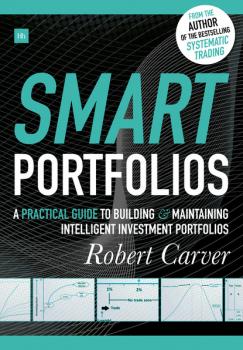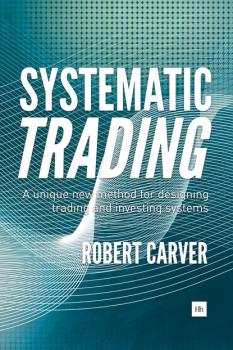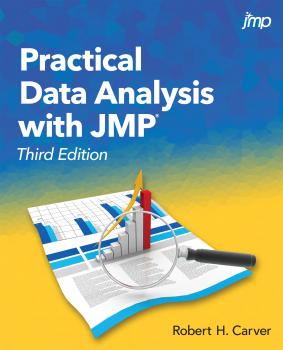Robert Carver
Список книг автора Robert CarverLeveraged Trading
With the right broker, and just a few hundred dollars or pounds, anyone can become a leveraged trader. The products and tools needed are accessible to all: FX, a margin account, CFDs, spread-bets and futures.
But this level playing field comes with great risks. Trading with leverage is inherently dangerous. With leverage, losses and costs – the two great killers for traders – are magnified.
This does not mean leverage must be avoided altogether, but it does mean that it needs to be used safely. In <i>Leveraged Trading</i>, Robert Carver shows you how to do exactly that, by using a trading system. A trading system can be employed to tackle those twin dangers of serious losses and high costs.
The trading systems introduced in this book are simple and carefully designed to use the correct amount of leverage and trade at a suitable frequency. Robert shows how to trade a simple Starter System on its own, on a single instrument and with a single rule for opening positions.
He then moves on to show how the Starter System can be adapted, as you gain experience and confidence. The system can be diversified into multiple instruments and new trading rules can be added. For those who wish to go further still, advice on making more complex improvements is included: how to develop your own trading systems, and how to combine a system with your own human judgement, using an approach Robert calls Semi-Automatic Trading.
For those trading with leverage, looking for a way to take a controlled approach and manage risk, a properly designed trading system is the answer. Pick up <i>Leveraged Trading</i> and learn how.
Smart Portfolios
Smart Portfolios is about building and maintaining smart investment portfolios. At its heart are the three key questions every investor needs to answer: 1. What to invest in. 2. How much to invest. 3. When to make changes to a portfolio. Author Robert Carver addresses these three areas by providing a single integrated approach to portfolio management. He shows how to follow a step-by-step process to build a multi-asset investment portfolio, and how to rebalance the portfolio efficiently. He covers both investment in collective funds like ETFs, and also direct investment in individual equities. Important features include: – Why forecasting future returns is so difficult, and how to account for uncertainty when making investment decisions. – How to accurately calculate the true costs of an investment, including costs that you may not even be aware of. – How to select the best ETF for each asset class. – How to compare the costs and other features of different ETFs. – How to select individual shares. – Calculating the number of shares needed for adequate diversification. – How to use systematic forecasting algorithms to adjust portfolio allocations. – How to cut trading costs through smart rebalancing strategies and execution tactics. Robert Carver also explains how to blend assets with different levels of risk, and how to construct portfolios that suit the level of risk that the investor can cope with. Smart Portfolios is detailed, comprehensive, and full of practical methods, rules of thumb and techniques, all fully explained with examples. It is intended for professional investors worldwide, including financial advisors, private bankers, wealth managers and institutional funds; as well as experienced private investors.
Systematic Trading
This is not just another book with yet another trading system. This is a complete guide to developing your own systems to help you make and execute trading and investing decisions. It is intended for everyone who wishes to systematise their financial decision making, either completely or to some degree. Author Robert Carver draws on financial theory, his experience managing systematic hedge fund strategies and his own in-depth research to explain why systematic trading makes sense and demonstrates how it can be done safely and profitably. Every aspect, from creating trading rules to position sizing, is thoroughly explained. The framework described here can be used with all assets, including equities, bonds, forex and commodities. There is no magic formula that will guarantee success, but cutting out simple mistakes will improve your performance. You'll learn how to avoid common pitfalls such as over-complicating your strategy, being too optimistic about likely returns, taking excessive risks and trading too frequently. Important features include: – The theory behind systematic trading: why and when it works, and when it doesn't. – Simple and effective ways to design effective strategies. – A complete position management framework which can be adapted for your needs. – How fully systematic traders can create or adapt trading rules to forecast prices. – Making discretionary trading decisions within a systematic framework for position management. – Why traditional long only investors should use systems to ensure proper diversification, and avoid costly and unnecessary portfolio churn. – Adapting strategies depending on the cost of trading and how much capital is being used. – Practical examples from UK, US and international markets showing how the framework can be used.
Systematic Trading is detailed, comprehensive and full of practical advice. It provides a unique new approach to system development and a must for anyone considering using systems to make some, or all, of their investment decisions.
Preparing Data for Analysis with JMP
Access and clean up data easily using JMP®! Data acquisition and preparation commonly consume approximately 75% of the effort and time of total data analysis. JMP provides many visual, intuitive, and even innovative data-preparation capabilities that enable you to make the most of your organization's data. Preparing Data for Analysis with JMP® is organized within a framework of statistical investigations and model-building and illustrates the new data-handling features in JMP, such as the Query Builder. Useful to students and programmers with little or no JMP experience, or those looking to learn the new data-management features and techniques, it uses a practical approach to getting started with plenty of examples. Using step-by-step demonstrations and screenshots, this book walks you through the most commonly used data-management techniques that also include lots of tips on how to avoid common problems. With this book, you will learn how to: Manage database operations using the JMP Query Builder Get data into JMP from other formats, such as Excel, csv, SAS, HTML, JSON, and the web Identify and avoid problems with the help of JMP’s visual and automated data-exploration tools Consolidate data from multiple sources with Query Builder for tables Deal with common issues and repairs that include the following tasks: reshaping tables (stack/unstack) managing missing data with techniques such as imputation and Principal Components Analysis cleaning and correcting dirty data computing new variables transforming variables for modelling reconciling time and date Subset and filter your data Save data tables for exchange with other platforms
Practical Data Analysis with JMP, Third Edition
Master the concepts and techniques of statistical analysis using JMP Practical Data Analysis with JMP, Third Edition, highlights the powerful interactive and visual approach of JMP to introduce readers to statistical thinking and data analysis. It helps you choose the best technique for the problem at hand by using real-world cases. It also illustrates best-practice workflow throughout the entire investigative cycle, from asking valuable questions through data acquisition, preparation, analysis, interpretation, and communication of findings. The book can stand on its own as a learning resource for professionals, or it can be used to supplement a college-level textbook for an introductory statistics course. It includes varied examples and problems using real sets of data. Each chapter typically starts with an important or interesting research question that an investigator has pursued. Reflecting the broad applicability of statistical reasoning, the problems come from a wide variety of disciplines, including engineering, life sciences, business, and economics, as well as international and historical examples. Application Scenarios at the end of each chapter challenge you to use your knowledge and skills with data sets that go beyond mere repetition of chapter examples. New in the third edition, chapters have been updated to demonstrate the enhanced capabilities of JMP, including projects, Graph Builder, Query Builder, and Formula Depot.




